nashville style hot chicken
16 Nov 2014Intro
Years ago, during the beginnings of Nashville’s hot chicken renaissance, Jim Ridley posted a simple recipe for a basic portion of nashville-style hot chicken. Not much to quibble with, on the whole, except possibly the choice of chicken breast as the medium (people eat chicken breasts?). I was intrigued, and thus my quest to replicate my favorite hot chicken was launched. I wrote this a few years ago, documenting my first large-scale attempt to make it. It didn’t go badly, but it wasn’t quite right, either. Specifically, in thinking of hot chicken as a uniquely southern dish (which it is), I looked up a recipe for traditional southern fried chicken as the base. This was a mistake. The result was a buttermilk-brined, very thick double-dredged method resulting in a very thick, bready crust. The combination made for a bready sweetness that competed with the heat and made a chore out of peeling away/eating the breading before you could even get to the meat.
So what, then is the goal? Opinions vary, but in my mind, the archetypical Nashville-style Hot Chicken requires a thin, flaky breaded crust, and my preferences reflect this. Prince’s and Hattie B’s more or less represent the gold standard in this regard. This is a photo of a “Shut the Cluck Up” leg quarter from Hattie B’s:
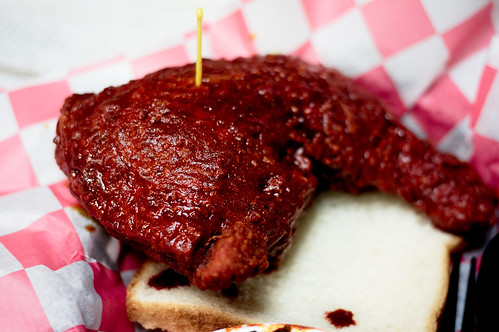
You can see in that photo the flaky ridges of crust providing a home for the tasty cayenne goodness, without presenting an overwhelming barrier to the chicken itself. It’s a beautiful thing – basically, they do it right. Turning fried chicken into hot chicken is quite easy, but it’s the replication of this particular style of fried chicken that has proven most challenging to me.
So, rather than post a traditional recipe, I’m going to break this post out into various parts of the recipe, including areas that are more/less contentious, posting my experience with them.
To Brine or Not to Brine?
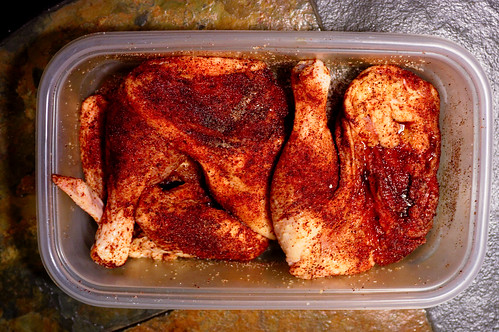
- Wet brine: It’s hard to go wrong with a good ol’ fashioned brine of water + salt + herb/spices. One complicating factor with chicken is the crispiness of the skin, and I have found that a wet brine can result in soggy skin.
- WINNER SO FAR: Dry brine: A different approach is to simply mix up your herbs/spices with salt and sugar in a large ziplock bag or container, shake vigorously and let it sit overnight. This yields somewhat the same effect of infusing with flavor, but has the added benefit that the salt draws some of the moisture out of the skin. The downside, in my experience, is that if you let it sit too long (even overnight), the chicken meat itself can get too dried out, resulting in a rubbery texture after cooking. Note: rinse the salt/spices off of the chicken and pat it dry before breading + frying.
- Combination? I’ve contemplated doing some sort of overnight wet brine + a briefer dry brine w/ salt to let the skin “air out”, but at that point it really sounds like more work than it’s worth.
- No brine: This is always an option. Does brining really make that much of a difference? Hard to say. Don’t feel guilty if you don’t bother at all – chicken is pretty tasty and moist as it is.
The Breading
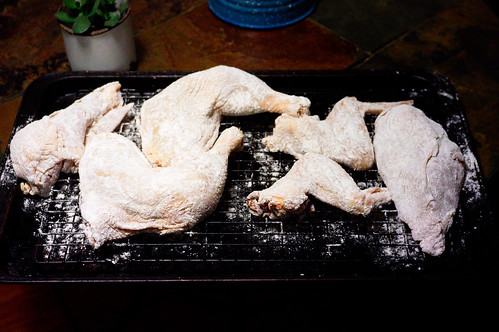
- Simple flour dredging: Pretty much what it sounds like, this simply involves dredging the chicken in all-purpose flour. You have to be careful to let the chicken sit for a spell (>30 minutes at least) to let the flour start to bind to the skin, otherwise it will all fall off while frying. I’ve not had a lot of success with this method – flour still tended to fall off, what crust did form was a spottily-covered flat/homogenous crust.
- Flour dredging + egg wash: my next experiment was to take the aforementioned flour dredged chicken and apply an egg wash + another dredging in flour. This yielded a more substantial crust and a fairly nice-looking final product as seen here. Aesthetically, this is as close as I’ve come to breading that resembles the chicken I’m after. The failing of this attempt was that the crust that formed was not very porous and had a brittle, hard texture that didn’t soak up the sauce and wasn’t super pleasant to bite into.
- Southern-style buttermilk dredging: As mentioned above, just .. don’t do this. Not for this kind of chicken.
- WINNER SO FAR: Cleverer Sciencey flour dredging (i.e. korean-style fried chicken): This was my most recent experiment, and I think it holds the key for a future final product. This attempt was loosely based on the instructions here for making a korean-style fried chicken wing. The goal is to use a careful combination of baking powder, salt and corn starch, letting it rest and then coating with a thin vodka/water-based batter. Read the linked article for more than you probably want to know about the science behind all this, if you like. The result was a nice, porous crust, though still a bit thicker than I intended (I think my batter was low on water). It was also rather homogenous and lacked the “flakes” so visible in my ideal fried chicken. I suspect that a combination of this method with an egg wash might be the final answer.
Frying
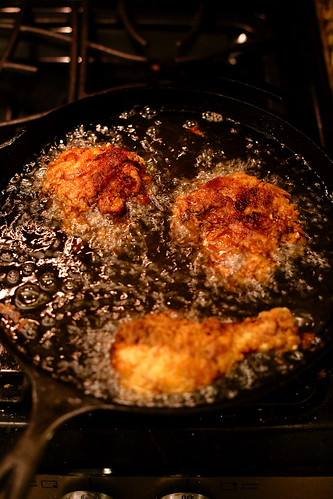
- There isn’t a lot of contention (that I know of) when it comes to frying the chicken. Use an oil with a high smoke point. I use peanut oil that I save in my fridge after filtering for repeated use. I’ve heard that some people use chicken fat, though I would wonder about the smoke point of that?
- I fry in my cast iron skillet. I want to upgrade to a dutch oven at some point both to avoid burns from the bottom of the currently shallow pan, and also to reduce the risk of grease fire spillage.
- Try to peg the temperature of the oil at around 350F. It will drop when you add the chicken.
- Don’t overcrowd the pan. This was almost pushing it for me, especially since I am using a shallower skillet and not a dutch oven, so my oil doesn’t have a lot of thermal capacity. If you add too much at once, the temperature will drop, and you will get nasty chicken.
- Can you bake the chicken if you want a healthier alternative? No.
The Sauce

Ah, the sauce. This is what turns regular fried chicken into Nashville hot chicken. As I’ve said in the past, there’s nothing particularly magical about it – the dish mostly leans heavily on seemingly obscene quantities of powdered cayenne pepper. The basic recipe, as also detailed in the recipe linked above:
- A few tablespoons of lard, microwaved to soften
- Powdered cayenne pepper – exact quantities are hard to give, here, but you want enough powder that the pepper itself with the lard starts to form a thick paste. Don’t be shy here. If you’re not scared of it, it’s not Nashville-style hot chicken.
As with everything, though, connoisseurship abounds, and there are some decisions to make.
- Cayenne or other peppers? Despite its household status, you really can derive a truly staggering level of heat from cayenne via quantity alone. But there is an upper limit, and clearly the hot chicken establishments in Nashville add Something Else for their upper echelon heat levels. Naturally, I have no idea what they add (I’ve heard it rumored that Hattie B’s shut-the-cluck-up involves ghost peppers). I’m a traditionalist, so I think most of the flavor should come from cayenne, but if you want to kick up the heat, you’ll need something else. I’d avoid any peppers that are smoked (I made this mistake with ghost pepper flakes once), since it turns the flavor into something else.
- Oil or lard? I didn’t really know this was a thing, but more and more recipes I see are starting to call for a sauce made with oil instead of lard. I’ve even gone to a few newer hot chicken places that are clearly using oil. I am deeply opposed to this. It was obvious that the chicken I had was made with oil, because the sauce tasted more like peanut oil than cayenne. Nope nope nope. I’m not opposed to some judicious supplementation of oil to make the paste a little runnier (some people use frying oil), but the base should be lard, in my opinion. The point is to have something to saturate with cayenne, so your chicken is thus saturated with cayenne, not to saturate your chicken with oil. That’s just gross.
- Sweet? I’m torn on this, partially because adding too much sugar was a huge fail the first time I made hot chicken, and the trauma runs deep. I think a little bit of sweet in the sauce is fine, but a little goes a looooooong way. I sometimes just put a few teaspoons of honey in mine. Don’t overdo it.
- Other Spices? Similarly, the first time I made hot chicken, I mixed in all sorts of go-to spices, in line with my usual “the more the merrier” madcap approach to cooking. It wasn’t bad, but certain spices go a long way towards changing the flavor profile, and you can’t be reckless here. Garlic powder can quickly overwhelm everything. These days I don’t add anything, except for ground mustard powder, which was an excellent tip from hot chicken judge and affluent west nashvillian of note jrlind. As he said, mustard helps make the heat a more nasal experience, rounding out the masochism of it all. Every place and person probably has their own mix of spices they do add, but I’d be judicious and sparing – nashville hot chicken flavor is largely about the cayenne.
Serving
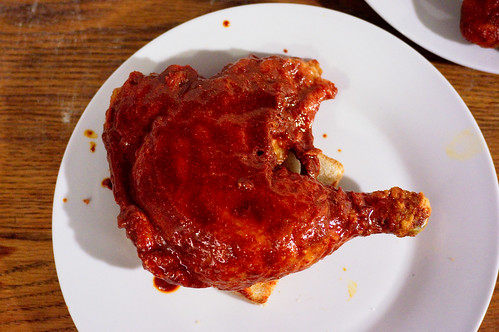
Serve on a slice or two of white bread, with pickles. Pickles not shown. But don’t forget the bread. It soaks up the sauce and is arguably the best part!
That’s it! Happy eating!